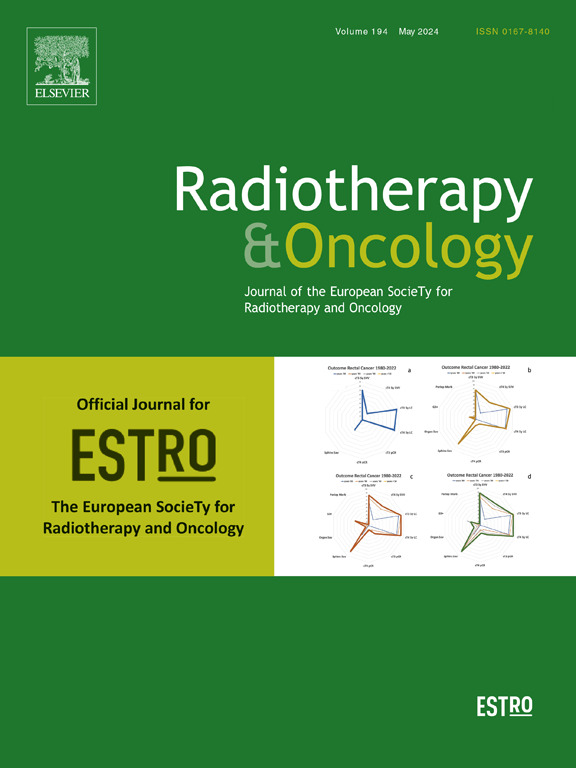Dose calculation accuracy of a new high-performance ring-gantry CBCT imaging system for prostate and lung cancer patients
IF 4.9
1区 医学
Q1 ONCOLOGY
引用次数: 0
Abstract
Background and purpose
The recently introduced high-performance CBCT imaging system called HyperSight offers improved Hounsfield units (HU) accuracy, a larger CBCT field-of-view and improved image quality compared to conventional ring gantry CBCT, possibly enabling treatment planning on CBCT imaging directly. In this study, we evaluated whether the dose calculation accuracy on HyperSight CBCT was sufficient for treatment planning in prostate and lung cancer patients.
Materials and methods
HyperSight CBCT was compared to planning CT (pCT) in terms of HU-to-mass density (MD) calibration curves. For twenty prostate patients and twenty lung patients, differences in DVH parameters, and 3D global gamma between dose distributions calculated on pCT and free breathing HyperSight CBCT were evaluated. For this purpose, HyperSight CBCT acquired at the first fraction was rigidly registered to the pCT, delineations from the CT were propagated and the dose was recalculated on the HyperSight CBCT.
Results
For each insert of the HU-to-MD calibration phantom, the HU values of HyperSight CBCT and pCT agreed within 35 HU. For prostate maximum deviations in PTV Dmean, V95% and V107% were 1.8 %, −1.1 % and < 0.1 % respectively. For lung PTV V95% was generally lower (median −1.1 %) and PTV V107% was generally higher (median 1.1 %) on HyperSight CBCT due to breathing motion artifacts. The average (±SD) 2 %/2mm gamma pass rate was 98.7 %±1.2 % for prostate cancer patients and 96.2 %±2.1 % for lung cancer patients.
Conclusion
HyperSight CBCT enabled accurate dose calculation for prostate cancer patients, without implementation of a specific HyperSight CBCT-to-MD curve. For lung cancer patients, breathing motion hampered accurate dose calculations.
新型高性能环形龙门 CBCT 成像系统对前列腺癌和肺癌患者的剂量计算精度。
背景和目的:与传统的环形龙门 CBCT 相比,最近推出的高性能 CBCT 成像系统 HyperSight 可提供更高的 Hounsfield 单位(HU)精度、更大的 CBCT 视场和更好的图像质量,从而有可能直接在 CBCT 成像上进行治疗规划。在这项研究中,我们评估了 HyperSight CBCT 的剂量计算精度是否足以用于前列腺癌和肺癌患者的治疗计划。对 20 名前列腺癌患者和 20 名肺癌患者的 DVH 参数和 3D 全局伽马值进行了评估,这些参数和伽马值在计划 CT 与自由呼吸 HyperSight CBCT 计算的剂量分布之间存在差异。为此,在第一部分获得的 HyperSight CBCT 与 pCT 进行了刚性注册,CT 的划线被传播,剂量在 HyperSight CBCT 上重新计算:对于每个插入的 HU-to-MD 校准模型,HyperSight CBCT 和 pCT 的 HU 值都在 35 HU 范围内。对于前列腺,由于呼吸运动伪影,HyperSight CBCT 的 PTV Dmean、V95% 和 V107% 的最大偏差分别为 1.8 %、-1.1 %,95% 一般较低(中位数为-1.1 %),PTV V107% 一般较高(中位数为 1.1 %)。前列腺癌患者的平均(±SD)2 %/2mm 伽马通过率为 98.7 %±1.2%,肺癌患者为 96.2 %±2.1%:结论:HyperSight CBCT 可以准确计算前列腺癌患者的剂量,而无需实施特定的 HyperSight CBCT 至 MD 曲线。对于肺癌患者,呼吸运动妨碍了剂量的准确计算。
本文章由计算机程序翻译,如有差异,请以英文原文为准。
求助全文
约1分钟内获得全文
求助全文
来源期刊

Radiotherapy and Oncology
医学-核医学
CiteScore
10.30
自引率
10.50%
发文量
2445
审稿时长
45 days
期刊介绍:
Radiotherapy and Oncology publishes papers describing original research as well as review articles. It covers areas of interest relating to radiation oncology. This includes: clinical radiotherapy, combined modality treatment, translational studies, epidemiological outcomes, imaging, dosimetry, and radiation therapy planning, experimental work in radiobiology, chemobiology, hyperthermia and tumour biology, as well as data science in radiation oncology and physics aspects relevant to oncology.Papers on more general aspects of interest to the radiation oncologist including chemotherapy, surgery and immunology are also published.
 求助内容:
求助内容: 应助结果提醒方式:
应助结果提醒方式:


